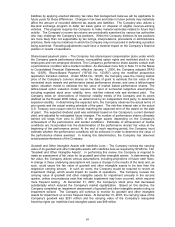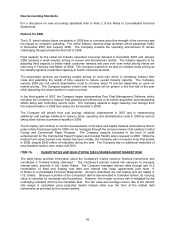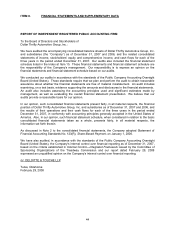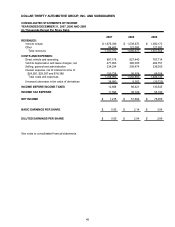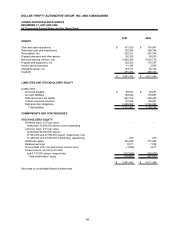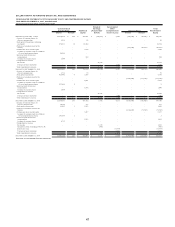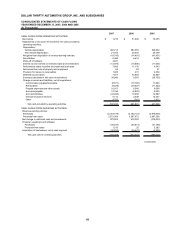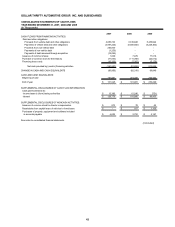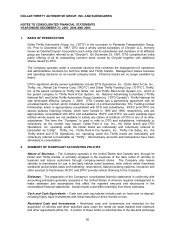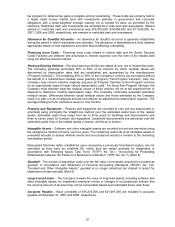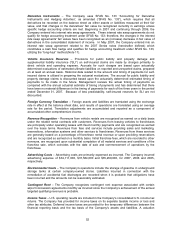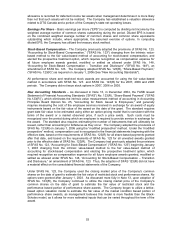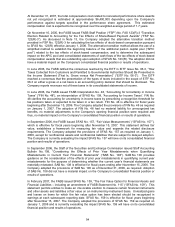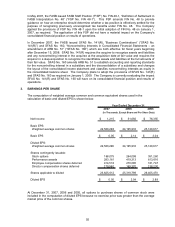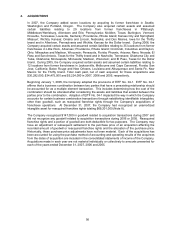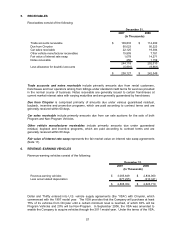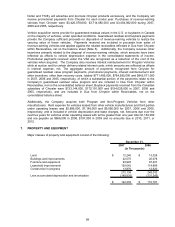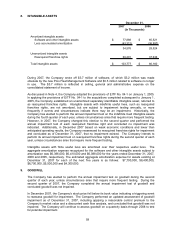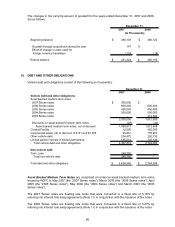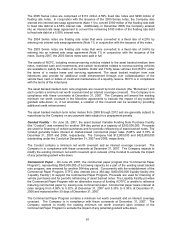Thrifty Car Rental 2007 Annual Report Download - page 59
Download and view the complete annual report
Please find page 59 of the 2007 Thrifty Car Rental annual report below. You can navigate through the pages in the report by either clicking on the pages listed below, or by using the keyword search tool below to find specific information within the annual report.tax program for deferred tax gains on eligible vehicle remarketing. These funds are primarily held in
a highly rated money market fund with investments primarily in government and corporate
obligations with a dollar-weighted average maturity not to exceed 60 days, as permitted by the
indenture. Restricted cash and investments are excluded from cash and cash equivalents. Interest
earned on restricted cash and investments was $13,975,000, $16,896,000 and $11,045,000, for
2007, 2006 and 2005, respectively, and remains in restricted cash and investments.
Allowance for Doubtful Accounts – An allowance for doubtful accounts is generally established
during the period in which receivables are recorded. The allowance is maintained at a level deemed
appropriate based on loss experience and other factors affecting collectibility.
Financing Issue Costs – Financing issue costs related to vehicle debt and the Senior Secured
Credit Facilities are deferred and amortized to interest expense over the term of the related debt
using the effective interest method.
Revenue-Earning Vehicles – Revenue-earning vehicles are stated at cost, net of related discounts.
The Company generally purchases 50% to 60% of its vehicles for which residual values are
determined by depreciation rates that are established and guaranteed by the manufacturers
(“Program Vehicles”). The remaining 40% to 50% of the Company’s vehicles are purchased without
the benefit of a manufacturer residual value guaranty program (“Non-Program Vehicles”). Also, the
Company may convert vehicles originally acquired as Program Vehicles to Non-Program Vehicles
on an opportunistic basis to lower vehicle depreciation costs. For these Non-Program Vehicles, the
Company must estimate what the residual values of these vehicles will be at the expected time of
disposal to determine monthly depreciation rates. The Company continually evaluates estimated
residual values. Differences between actual residual values and those estimated by the Company
result in a gain or loss on disposal and are recorded as an adjustment to depreciation expense. The
average holding term for vehicles is seven to nine months.
Property and Equipment – Property and equipment are recorded at cost and are depreciated or
amortized using principally the straight-line method over the estimated useful lives of the related
assets. Estimated useful lives range from ten to thirty years for buildings and improvements and
three to seven years for furniture and equipment. Leasehold improvements are amortized over the
estimated useful lives of the related assets or leases, whichever is shorter.
Intangible Assets – Software and other intangible assets are recorded at cost and amortized using
the straight-line method primarily over five years. The remaining useful life of all intangible assets is
evaluated annually to assess whether events and circumstances warrant a revision to the remaining
amortization period.
Reacquired franchise rights, established upon reacquiring a previously franchised location, are not
amortized as they have an indefinite life, rather they are tested annually for impairment in
accordance with Emerging Issues Task Force ("EITF") No. 04-1, "Accounting for Preexisting
Relationships between the Parties to a Business Combination" ("EITF No. 04-1") (Note 8).
Goodwill – The excess of acquisition costs over the fair value of net assets acquired is recorded as
goodwill. In accordance with Statement of Financial Accounting Standards (“SFAS”) No. 142,
“Goodwill and Other Intangible Assets,” goodwill is no longer amortized but instead is tested for
impairment at least annually (Note 9).
Long–Lived Assets – The Company reviews the value of long-lived assets, including software and
other intangible assets, for impairment whenever events or changes in circumstances indicate that
the carrying amount of an asset may not be recoverable based upon estimated future cash flows.
Accounts Payable – Book overdrafts of $16,333,000 and $21,491,000 are included in accounts
payable at December 31, 2007 and 2006, respectively.
51


